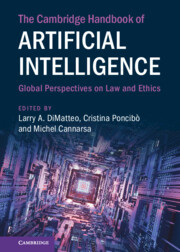Book contents
- The Cambridge Handbook of Artificial Intelligence
- The Cambridge Handbook of Artificial Intelligence
- Copyright page
- Contents
- Figures
- Contributors
- Foreword
- Preface
- Part I AI: Development and Trends
- Part II AI: Contracting and Corporate Law
- Part III AI and Liability
- Part IV AI and Physical Manifestations
- 12 Liability for Autonomous Vehicle Accidents
- 13 Interconnectivity and Liability
- 14 Liability Standards for Medical Robotics and AI
- Part V AI and Intellectual Property Law
- Part VI Ethical Framework for AI
- Part VII Future of AI
13 - Interconnectivity and Liability
AI and the Internet of Things
from Part IV - AI and Physical Manifestations
Published online by Cambridge University Press: 28 July 2022
- The Cambridge Handbook of Artificial Intelligence
- The Cambridge Handbook of Artificial Intelligence
- Copyright page
- Contents
- Figures
- Contributors
- Foreword
- Preface
- Part I AI: Development and Trends
- Part II AI: Contracting and Corporate Law
- Part III AI and Liability
- Part IV AI and Physical Manifestations
- 12 Liability for Autonomous Vehicle Accidents
- 13 Interconnectivity and Liability
- 14 Liability Standards for Medical Robotics and AI
- Part V AI and Intellectual Property Law
- Part VI Ethical Framework for AI
- Part VII Future of AI
Summary
Internet of Thing (IoT)s. It focuses in particular on the question of liability in circumstances where an IoT system has not performed as expected and where this has resulted in loss or damage. The authors argue that the combination of AI and the IoT raises several novel aspects concerning the basis for assessing responsibility and of allocating liability for loss or damage, and that this will necessitate the development of a more creative approach to liability than generally followed in many legal systems. Linear liability based on contractual relationships and fault-based or strict liability of a wrongdoer in tort law are no longer sufficient to deal with the complex issues associated with the interaction of AI and the IoT. According to the authors, the values underpinning established liability systems, particularly in the field of consumer protection law, should be maintained in the context of new digital technology applications. The adoption of new digital technology applications cannot be a basis for imposing a lower threshold of liability than the level of liability established in other contexts.
Keywords
- Type
- Chapter
- Information
- The Cambridge Handbook of Artificial IntelligenceGlobal Perspectives on Law and Ethics, pp. 179 - 199Publisher: Cambridge University PressPrint publication year: 2022

